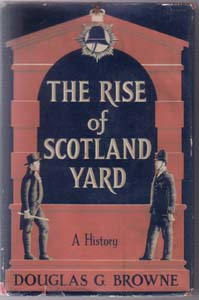| Hardcover book with Dust Jacket by Douglas G. Browne Over 390 pages Printed in Great Britain We do not see any copyright date in it " Undoubtedly the most remarkable police organization in the annals of history is London's Metropolitan Police - better and more familiarly known as Scotland Yard, Responsible for the maintenance of order in all but one square mile of the world's greatest capital, its large outer divisions now extend far into the counties outside London. Its methods of law enforcement have long been the model for police forces around the world and its history is as colorful as it is inspiring. But even beyond this the history of the Yard is bound up with the British national and political background of more than one hundred and twenty years. " " In this book, Douglas G. Browne tells the history of Scotland Yard and shows how it has arrived through the years at its present lofty position. Privileges granted by the authorities at New Scotland Yard have enabled copious use to be made, often for the first time, of the official records of the Metropolitan Police. Except for particular instances which are of interest in their own right, police work of the routine kind is touched upon only where it bears upon the main theme of the book - the development of a remarkable organization of a typically British character. Civilian but disciplined, semimilitary but unarmed, affected in some degree by every change of government, constantly improvising to meet changing conditions, the Metropolitan Police still maintains and cherishes the traditions of public services impressed upon it a hundred and twenty-six years ago by Robert Peel. " " DOUGLAS G. BROWNE is a native of London and the grandson of Hablot K. Browne who, under his nom de plume of Phiz, is remembered as the illustrator of some of Dickens' best works. Educated in British schools, he studied art, but eventually decided to be a writer. He has numerous published works to his credit including short stories, novels and general books. " Like many other authors, Browne called main sections "Books". Contents includes: " BOOK ONE
THE OLD POLICE Chapter 1. The Metropolis: 1050 to 1600 Chapter 2. The Trading Justice and the Birth of Bow Street Chapter 3. The Fieldings Chapter 4. Wilkes, Parliament, and the Gordon Riots Chapter 5. The First Police Magistrates and the River Police BOOK TWO
THE NEW POLICE Chapter 6. A London Park Chapter 7. A Second Parliamentary Campaign Chapter 8. The Birth of Scotland Yard Chapter 9. Organization and Early Troubles Chapter 10. A Decade of Consolidation Chapter 11. A Detective Office Chapter 12. "King" Mayne Chapter 13. Road, Rail, and Rugeley BOOK THREE
THE MODERN POLICE Chapter 14. A New Commissioner Chapter 15. The Coming of the C.I.D. Chapter 16. The Commissioners and the Home Office Chapter 17. New Scotland Yard Chapter 18. The 1890's Chapter 19. Fingerprints and the Beck Case Chapter 20. Mme. D'Angely and Inspector Syme Chapter 21. Tottenham and Sidney Street Chapter 22. The War Years Chapter 23. The Mutinies Chapter 24. Press Attacks and the General Strike Chapter 25. Lord Byng Chapter 26. Lord Trenchard Chapter 27. The Second World War Epilogue
A Select Bibliography
Index ILLUSTRATIONS Metropolitan Police Headquarters
John Townsend, Bow Street Runner
Sir Thomas de Veil
Sir John Fielding
Patrick Colquhoun
Captain John Harriott
"Peelers"
Sir Robert Peel
Old Scotland Yard, Whitehall Place
The Public Office in Bow Street
The Last Watchman
Page from the Police Gazette of 1830
Colonel Sir Charles Rowan
Sir Richard Mayne
"Ruffianly Policeman"
Bow Street, 1851
Bow Street, 1879
The Attempt to blow up Government Offices in Charles Street, Westminster
The Black Museum at Scotland Yard in its Early Days
Colonel Sir Edmund Henderson
James Monro
Sir Charles Warren
Sir Edward Henry
A Constable, 1829 and 1956
The Women Police, 1920 and 1956 " This book looks pretty old and is in fair to good condition for its age.
The dust jacket is very worn with several tears.
There are some spots and discoloration on the cover of the book.
There are some aging spots on the inside covers, first and last pages and on the side edges of the pages and a few pages have some water stains along the edges.
The pages are slightly yellowed due to aging.
No torn or ripped pages.
No other markings or writing. | 





 for 1 item(s)
for 1 item(s)










